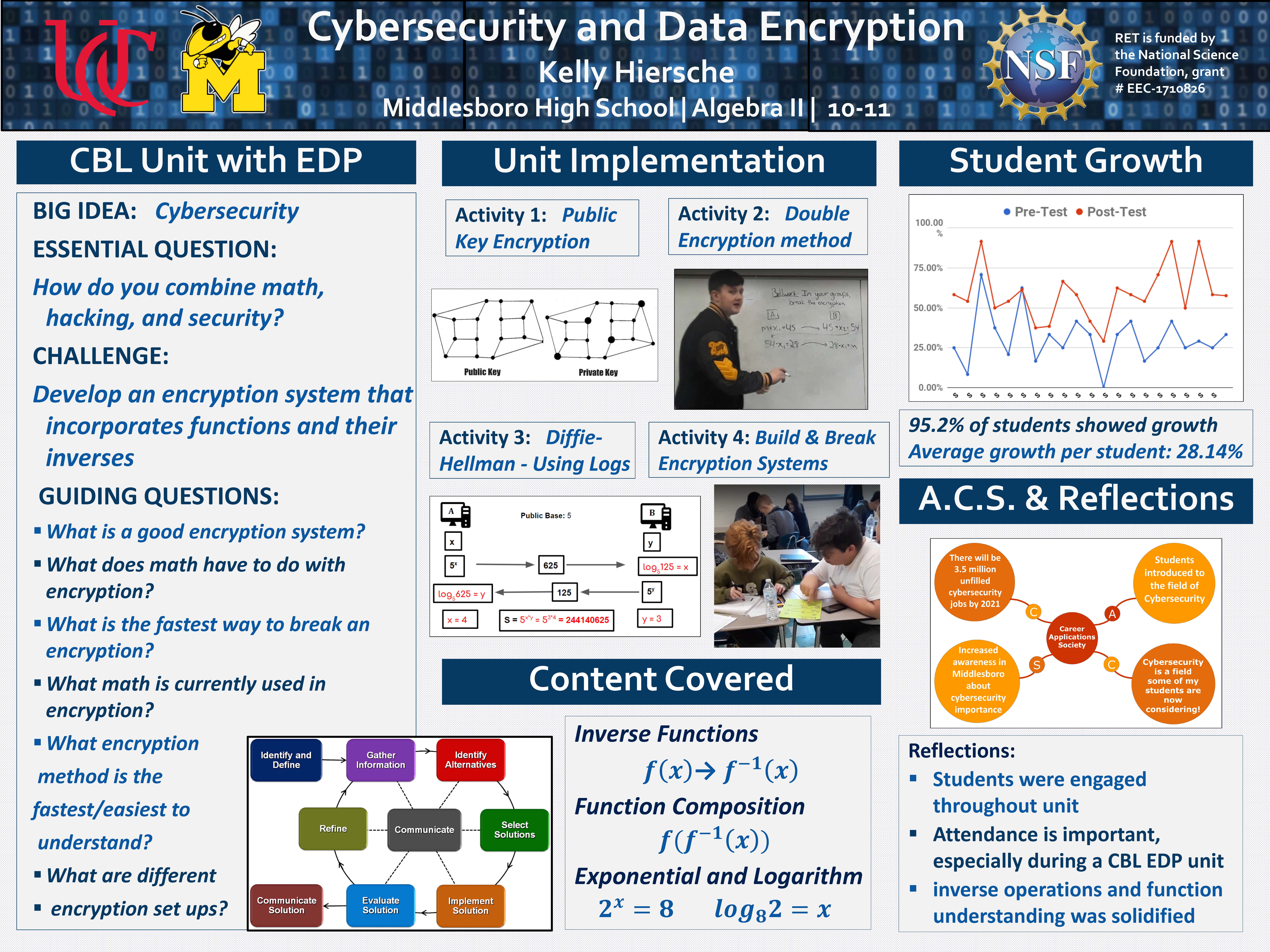Research Experience for Teachers (2018-2019)
Cybersecurity and Encryption
 |
||||||
|
||||||
|
Pre/Post Test: None needed |
||||||
Keywords:
|
|
The Big Idea (including global relevance) Encrypting Information to protect data: – All people send important information over the internet, including students and their parents. This unit will enlighten students into how data is encrypted, how to keep their information safe, and they will develop a way to safely encrypt data. |
|
Essential Questions
|
|
The Hook Students will be shown two videos from news sources that explain recent successes in hacking people’s Snap Chat accounts/fortnite or other culturally relevant topic. Students will then participate in an activity where they use a simple system to encrypt a message, and then find out how to break this encryption. Once they figure out how to break and fix it, they will look for ways to make this method more secure. (This is a visual, pattern based method with only simple addition). |
|
The Challenge Snap Chat has hired your firm to develop a secure method of encrypting data being sent over the internet using mathematical functions. |
|
Guiding Questions
|
ACS (Real world applications; career connections; societal impact)
As the internet and technology becomes more prevalent in the world, so does the need Cybersecurity and student understanding of how information is keep safe in on the internet. Students can utilize Algebra 2 to encrypt data in a method which could realistically be used to keep information secure.
Societal impact would come from the ability of this Challenge to peak the interest of students in Computer Science to help make this a field which students can consider as a future job opportunity. It also raises their awareness of the vulnerability of information they put online and provides context for discussing safe use of social media, online banking, etc.
Computer Science careers specifically Cryptographer, Cryptanalyst, Computer Engineer, Encryption specialist. – have not decided exactly how to introduce these – don’t know if guest speakers are available. Game design/encryption
Misconceptions
- I expect misconceptions in the differences between inverse function and function multiplication and function composition, because they are similar in process and both valid approaches to creating an encryption system. I also think there may be misconceptions between inverse operations and inverse functions.
Unit Lessons and Activities
- Lesson 1: Understanding Encryption Keys & Breaking Them - Lesson 1 will focus on the basics of encrypting information. Students will learn about public keys and privates keys. Students will use the Diffie-Hellman to be introduced to the concept of Logarithms as the inverse of exponential functions. Additionally, student will utilize exponent rules to create a secret key between to people.
- Activity 1: Introducing the Big Idea, the hook, Generating Essential Questions, Presentation of Challenge, Generation of Guiding Questions, gathering information
- Activity 2: Exponent rules and introduction of logs via Diffie-Hellman
- Lesson 2: Encryption with Algebra 2 - Lesson 2 will focus on the development and utilization of students’ knowledge of inverse functions to send encryption messages. Students will learn about double encryption with asymmetric keys.
- Activity 3: Encrypting with Inverse Functions, Gathering information, select solutions, communicate solutions, refine
- Activity 4: Make and Break the Encryptions: Implement solutions, evaluate solutions, refine
- Evidence of CBL: Lesson 1 Activity 1, Lesson 2 Activity 2
- Evidence of EDP: Lesson 1 Activity 1, Lesson 1 Activity 2, Lesson 2 Activity 1, Lesson 2 Activity 2
Additional Resources
